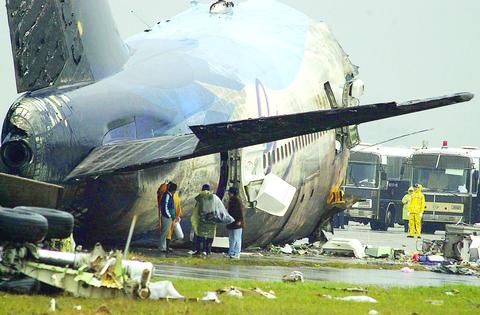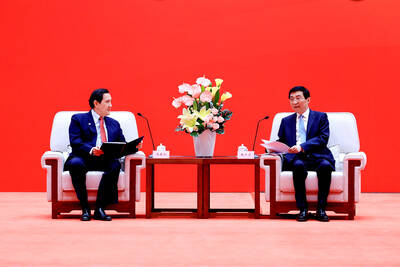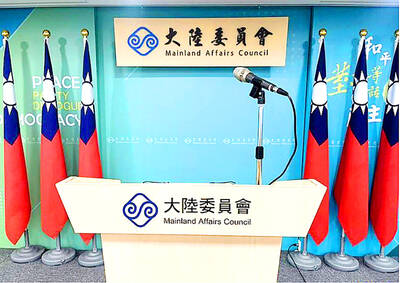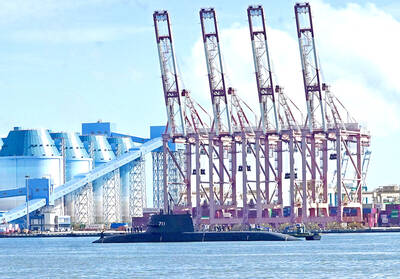Singapore Airlines, in a bid to share liability for last year's catastrophic crash of one of its aircraft at Taipei's Chiang Kai-shek (CKS) International Airport, has named Taiwan's airport authority as the third party in all civil suits filed against the airline.
How the move will affect Taiwan's Civil Aeronautics Administration, however, remains to be seen.
Accident review

PHOTO: TONY K. YAO, LIBERTY TIMES
SIA flight SQ006 to Los Angeles crashed on take-off at CKS International Airport on the evening of Oct. 31 while Taiwan was in the grip of a typhoon. The pilots of the doomed flight had mistakenly attempted a take-off from a runway that was closed for repair, except for taxiing purposes.
The jumbo jet burst into flames after hitting heavy construction machinery. Eighty-three of the 179 people aboard the airliner were killed.
The Aviation Safety Council (ASC, 飛安會), Taiwan's Cabinet-level crash investigation body, produced its fact report on the air crash in late February. The report simply details evidence gathered by investigators. The cause of the crash is still under analysis and the final report confirming the exact causes of the accident is expected in December.
According to the fact report, the pilots adopted an additional safety precaution due to the torrential rain of the typhoon. They used a navigational device that helps pilots properly align an aircraft on a runway during periods of low visibility.
The device, however, failed to work properly because the plane was positioned on the wrong runway -- and the crew failed to realize this before taking off.
All three of the flight's pilots were convinced that they were on the right runway.
Although the report did not blame the airport for the crash, it did, however, highlight some instances where the airport failed to conform to a number of international standards at the time the crash took place.
At the airport there were three guide lights to help direct the plane to the correct runway, runway 5L, at the point where the pilots mistakenly turned onto the wrong runway (5R). The two runways are parallel to each other. The aircraft should have passed 5R before turning into 5L.
The report found, however, that one of the lights was not working and another was very dim.
The airport also lacked "guard lights" to help pilots navigate from the taxiway to the correct runway during times of poor visibility.
There was a line painted on the taxiway leading to the closed runway, but no line leading to runway 5L.
International regulations require that a large cross be placed on the tarmac at the entrance to a closed runway but there was none at the entrance of runway 5R. Whether there should have been, in this case, however, is itself a contentious matter as the runway remained open for taxiing.
Why name the CAA?
According to Philip Bass, the airline's legal advisor, 50 lawsuits relating to the crash have been filed in the US to date. All these suits will be heard in Los Angeles.
As to why the airline has sought to add Taiwan's CAA to the civil suits filed against it in the US, an air accident litigation expert said, "Probably because the airline wants to defend its image and reputation."
He said that by taking such action, the airline would have a chance to sell the idea that it was laxness on the part of a third party that caused the human error of the pilots, which eventually led to the tragedy.
"But the airline has already admitted its responsibility in the case. I don't know how much this legal step will help it to clear its name," said a crash investigator.
The other purpose of the move, said the expert, was to have the third party share in the compensation payout if the airline loses the suits.
The Chicago-based Nolan Law Group, which is representing over 30 victims and families of victims of the crash, criticized the airline's compensation offer of US$400,000 for victim's families as "inadequate and far from generous."
"A death or disability leaves an economic wake behind it, and the civil justice system is the only process to try to soften the impact of this tragedy," said the law firm.
Bass said that the legal move to bring the CAA into the suits was in fact initiated by the airline's insurance company.
"We filed suits against the CKS authority [CAA] based on the content of the Aviation Safety Council's official report, released in February," said Bass, "But we cannot guarantee the details now."
"Moreover, a number of other comments of investigators have indicated inadequate installations and markings at the airport, which we think are relevant to the crash," added Bass.
Time saver
Some lawyers said that concerns over convenience and financial cost might persuade the judge to reach an early decision to accept SIA's naming of the Civil Aviation Authority as a third party in order to avoid the possibility of later suits covering the same ground.
Other lawyers, however, also said that it is possible that the judge may reject the airline's request. The Authority's officials therefore are not resigned to the prospect of being sued.
Chang Kuo-cheng (張國政), the Aviation Authority's deputy director emphasized that "There is only the factual report detailing evidence gathered so far, but an analysis of the causes of the crash is not ready yet. I don't understand on what grounds they can prove we are responsible."
"Yes, there were defects at the airport, but was that the cause of the crash?" he asked.
The aviation authority has prepared a list of candidates of lawyers to represent it in the event that Singapore Air's request is accepted by the judge. "But we have not had any legal notice stating that the authority has been named as a third party in the suits against the airline," emphasized Chang.
"We will prepare strategies for any possible situation," Chang said. "Even if the court approves the naming of the Civil Aviation Authority as a third party, it does not necessarily mean that the Authority will be held liable for the crash."
Singapore Airline's attorney Bass responded, "It is not for the court to accept [the naming of Civil Aviation Authority]. It is now for the Authority to respond to the suit."
Michael Gao (高聖悌), professor of international law at Soochow University, said the safety council's final report should be the document on which the court places most reliance in establishing responsibility for the accident. He said it was difficult to precisely determine the Civil Aviation Authority's role in the accident at this time.
"In fact, when the court hearings begin, it may be difficult to get investigators from Taiwan to attend as witnesses in a US court. Whether or not -- or to what extent -- the safety council will allow the use of the report in legal proceedings is also a matter of contention," Gao added.
"The US court may therefore observe whether Taiwan's prosecutors file suits against the Civil Aviation Authority on the basis of the final report, before determining the Authority's responsibility in the crash," said Gao.
Investigators said the crash report should not be used in judicial proceedings. Otherwise those involved in future accidents may be reluctant to give truthful accounts of what happened, which will hamper prevention of future accidents.
In any case, if the Civil Aviation Authority is accepted as a third party, the consequences for it will not be clear until verdicts have been reached in the suits, which is not expected until after the final crash report has been issued.
"Before the report is released at the end of the year, it is way too early to convince the court that the airport's administration had a direct bearing on the pilots' misjudgment," said a legal expert.

CHIP WAR: The new restrictions are expected to cut off China’s access to Taiwan’s technologies, materials and equipment essential to building AI semiconductors Taiwan has blacklisted Huawei Technologies Co (華為) and Semiconductor Manufacturing International Corp (SMIC, 中芯), dealing another major blow to the two companies spearheading China’s efforts to develop cutting-edge artificial intelligence (AI) chip technologies. The Ministry of Economic Affairs’ International Trade Administration has included Huawei, SMIC and several of their subsidiaries in an update of its so-called strategic high-tech commodities entity list, the latest version on its Web site showed on Saturday. It did not publicly announce the change. Other entities on the list include organizations such as the Taliban and al-Qaeda, as well as companies in China, Iran and elsewhere. Local companies need

CRITICISM: It is generally accepted that the Straits Forum is a CCP ‘united front’ platform, and anyone attending should maintain Taiwan’s dignity, the council said The Mainland Affairs Council (MAC) yesterday said it deeply regrets that former president Ma Ying-jeou (馬英九) echoed the Chinese Communist Party’s (CCP) “one China” principle and “united front” tactics by telling the Straits Forum that Taiwanese yearn for both sides of the Taiwan Strait to move toward “peace” and “integration.” The 17th annual Straits Forum yesterday opened in Xiamen, China, and while the Chinese Nationalist Party’s (KMT) local government heads were absent for the first time in 17 years, Ma attended the forum as “former KMT chairperson” and met with Chinese People’s Political Consultative Conference Chairman Wang Huning (王滬寧). Wang

CROSS-STRAIT: The MAC said it barred the Chinese officials from attending an event, because they failed to provide guarantees that Taiwan would be treated with respect The Mainland Affairs Council (MAC) on Friday night defended its decision to bar Chinese officials and tourism representatives from attending a tourism event in Taipei next month, citing the unsafe conditions for Taiwanese in China. The Taipei International Summer Travel Expo, organized by the Taiwan Tourism Exchange Association, is to run from July 18 to 21. China’s Taiwan Affairs Office spokeswoman Zhu Fenglian (朱鳳蓮) on Friday said that representatives from China’s travel industry were excluded from the expo. The Democratic Progressive Party government is obstructing cross-strait tourism exchange in a vain attempt to ignore the mainstream support for peaceful development

DEFENSE: The US would assist Taiwan in developing a new command and control system, and it would be based on the US-made Link-22, a senior official said The Ministry of National Defense is to propose a special budget to replace the military’s currently fielded command and control system, bolster defensive resilience and acquire more attack drones, a senior defense official said yesterday. The budget would be presented to the legislature in August, the source said on condition of anonymity. Taiwan’s decade-old Syun An (迅安, “Swift Security”) command and control system is a derivative of Lockheed Martin’s Link-16 developed under Washington’s auspices, they said. The Syun An system is difficult to operate, increasingly obsolete and has unresolved problems related to integrating disparate tactical data across the three branches of the military,